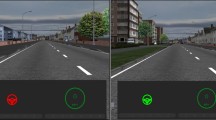Abstract
Conditional Automated Driving (SAE Level 3) is expected to be introduced to the consumer market within the next few years. In this level of automation, the dynamic driving task is executed by the system and the human driver can engage in non-driving related tasks and just has to intervene if requested by the system. As it is assumed, that the human driver may have problems regaining control of the vehicle, studies on take-over performance are in the focus of human factors research right now. It is examined whether the human driver is capable of regaining vehicle control and what factors influence take-over performance of the human driver. In this paper, take-over situations of two studies that just differed in the duration of the automated driving are compared. The studies were both conducted at BMW laboratories in a motion based driving simulator. Take-over performance of the participants was rated using the video-based TOC expert rating tool by three trained raters. Results suggest, that take-over performance strongly differs among individuals and that such take-over situations can cause problems for a majority of the participants. Especially in prolonged conditional automated driving the human driver needs to be supported when it comes to a take-over situation. The influence of the duration of the ride seems to be stronger than that of the non-driving related task.
Access this chapter
Tax calculation will be finalised at checkout
Purchases are for personal use only
Similar content being viewed by others
References
Eriksson A, Stanton NA (2017) Takeover time in highly automated vehicles: noncritical transitions to and from manual control. Hum Factors 59(4):689–705
Gold C (2016) Modeling of Take-Over Performance in Highly Automated Vehicle Guidance (Doctoral dissertation, Universität München)
Hergeth S, Lorenz L, Krems JF (2017) Prior familiarization with takeover requests affects drivers’ takeover performance and automation trust. Hum Factors 59(3):457–470
Jarosch O, Kuhnt M, Paradies S, Bengler K (2017) It’s Out of Our Hands Now! Effects of Non-Driving Related Tasks During Highly Automated Driving on Drivers’ Fatigue
Marberger C, Mielenz H, Naujoks F, Radlmayr J, Bengler K, Wandtner B (eds) (2017) Understanding and Applying the Concept of “Driver Availability” in Automated Driving. Springer
May JF, Baldwin CL (2009) Driver fatigue: the importance of identifying causal factors of fatigue when considering detection and countermeasure technologies. Transp Res Part F Traffic Psychol Behav 12(3):218–224
National Center for Statistics and Analysis (Oktober 2017) Drowsy Driving (2015) (Crash•Stats Brief Statistical Summary. Report No. DOT HS 812 446). Washington, DC: National Highway Traffic
Naujoks F, Wiedemann K, Schömig N, Jarosch O, Gold C (2018) Expert-based controllability assessment of control transitions from automated to manual driving. Manuscript submitted for publication
Neubauer C, Matthews G, Langheim L, Saxby D (2012) Fatigue and voluntary utilization of automation in simulated driving. Hum Factors J Hum Factors Ergon Soc 54(5):734–746
Petermann-Stock I, Hackenberg L, Muhr T, Mergl C. (2013) Wie lange braucht der Fahrer? Eine Analyse zu Übernahmezeiten aus verschiedenen Nebentätigkeiten während einer hochautomatisierten Staufahrt. 6. Tagung Fahrerassistenzsysteme. Der Weg zum automatischen Fahren
SAE International (2016 September 30) Taxonomy and Definitions for Terms Related to Driving Automation Systems for On-Road Motor Vehicles (J3016)
Schömig N, Hargutt V, Neukum A, Petermann-Stock I, Othersen I (2015) The interaction between highly automated driving and the development of drowsiness. Procedia Manuf. 3:6652–6659
Author information
Authors and Affiliations
Corresponding author
Editor information
Editors and Affiliations
Rights and permissions
Copyright information
© 2019 Springer Nature Switzerland AG
About this paper
Cite this paper
Jarosch, O., Bengler, K. (2019). Is It the Duration of the Ride or the Non-driving Related Task? What Affects Take-Over Performance in Conditional Automated Driving?. In: Bagnara, S., Tartaglia, R., Albolino, S., Alexander, T., Fujita, Y. (eds) Proceedings of the 20th Congress of the International Ergonomics Association (IEA 2018). IEA 2018. Advances in Intelligent Systems and Computing, vol 823. Springer, Cham. https://doi.org/10.1007/978-3-319-96074-6_54
Download citation
DOI: https://doi.org/10.1007/978-3-319-96074-6_54
Published:
Publisher Name: Springer, Cham
Print ISBN: 978-3-319-96073-9
Online ISBN: 978-3-319-96074-6
eBook Packages: Intelligent Technologies and RoboticsIntelligent Technologies and Robotics (R0)




